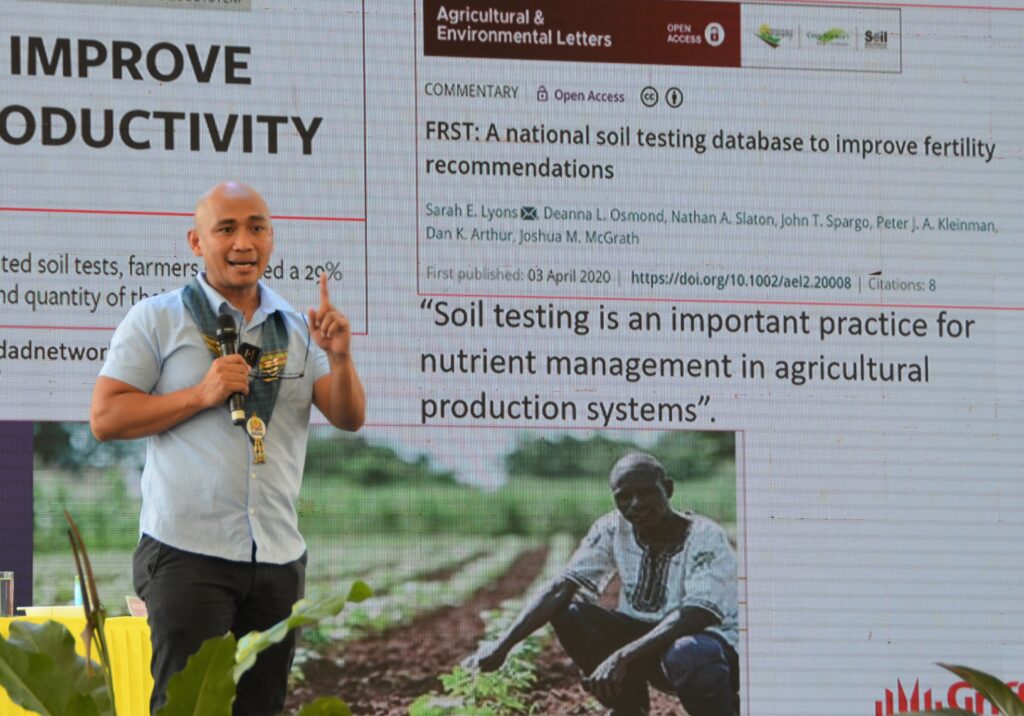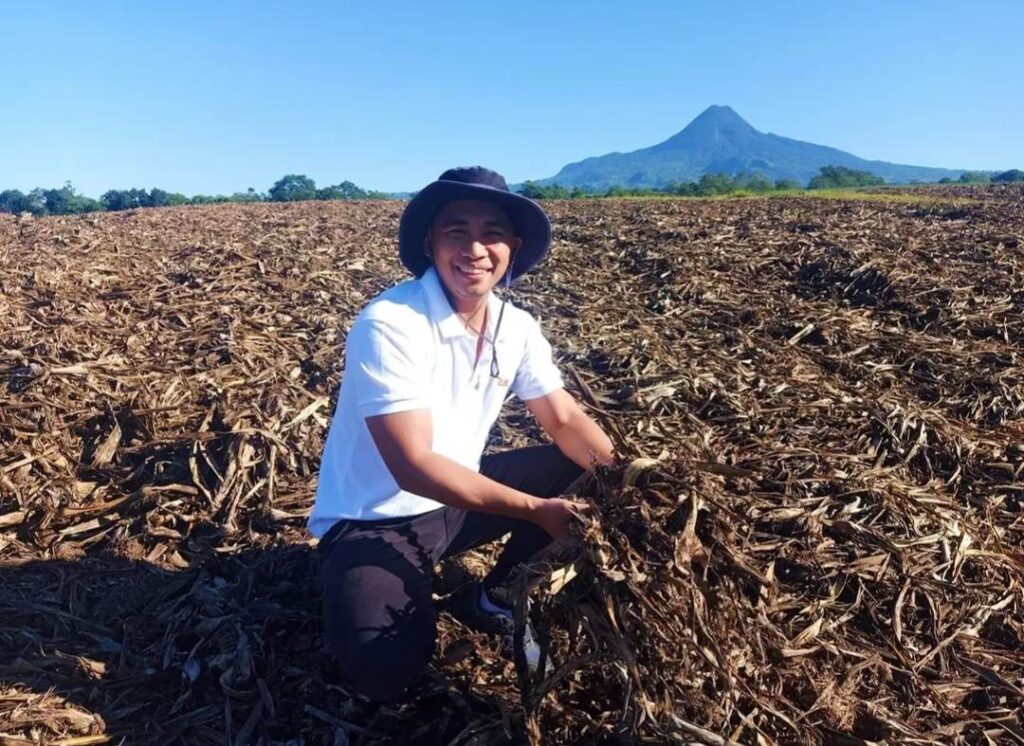By Henrylito D. Tacio
“All our food comes from soil,” wrote Paul Stamets, a mycologist and author of Mycelium Running. “When we destroy the biology of the soil, we destroy the food networks that give us life.”
This is perhaps the reason why Filipino farmers must conserve and protect topsoil at all cost as it is the primary resource in crop production. To do so, they need to know basic facts about it.
“We need to get to know our soils: Healthy soils produce healthy food and healthy people, and also support a healthy environment,” says Dr. Johnvie B. Goloran, an agricultural and environmental scientist. “Knowing the health of your soil is worth investing in.”
Dr. Goloran has a PhD in soil science and postdoctoral training in soil health and plant nutrition from Australia’s Griffith University and the Laguna-based International Rice Research Institute, respectively.
“I am very sure no Filipino farmer wants their fields to be infertile or degraded,” Dr. Goloran explains. “However, most farmers don’t know their soils. Because of this, they lose the opportunity to design or develop a strategic program/practice suitable for their farm lands.
Soil infertility
Experts claim one of the most pressing problems that cause soil infertility in farms is erosion, which Dr. Goloran defines as “the removal of the topsoil or the nutrient-rich soils via run-off or leaching.”
Topsoil is related to the earth much as the rind is related to an orange. It is the link between the rock core of the earth and the living things on its surface. It is also the foothold for the crops farmers grow.
In crop production, topsoil is the single most important resource. What most farmers don’t know is that topsoil built up over time. Pundits say it takes 200 to 1,000 years to form 2.5 centimeters of rich topsoil.
Soil erosion

On the average, farmlands are losing 2.5 centimeters of topsoil every 16 years, or 17 times faster than it can be replaced. No thanks to soil erosion.
“Soil erosion is an enemy to any nation – far worse than any outside enemy coming into a country and conquering it because it is an enemy you cannot see vividly,” said Harold R. Watson, an American agriculturist who used to be the director of the Mindanao Baptist Rural Life Center in Kinuskusan, Bansalan, Davao del Sur.
The reason why crops – cereals, fruits and vegetables – grow in fields is because the topsoil contains lots of nutrients. “Some forms of nutrients such as phosphorus and nitrate are highly mobile in water,” said Dr. Goloran. “As such, these nutrients are prone to leaching or surface run-off. This is the reason why minimum tillage and cover cropping are recommended as these provide protection of the topsoil.”
In minimum tillage, the soil is not turned over in contrast to intensive tillage, which changes the soil structure using ploughs. Cover cropping, on the other hand, is used to keep the soil protected with plants that may or may not be used as an additional cash crop.
Dr. Goloran believes farms whose soils have become infertile can still be saved. “First, farmers need to have good soil information for their farm lands, and based on these soil data, they can develop a suitable nutrient management practice for their farms,” he says.
Soil testing
This is where soil testing comes in. The goal of soil testing is to provide farmers an accurate assessment of the soil’s fertility to make proper fertilizer recommendations.

“Soil testing gives you the critical information on the nutritional status of your farm,” Dr. Goloran says. “This means that farmers would be able to select what type and rate of fertilizers are suitable to maintain a good nutritional status of the soils and at the same time address the nutritional requirements of the crops.”
Soil testing is very different from leaf tissue nutrient analysis, which determines if the crop has had a sufficient supply of essential nutrients. Dr. Goloran explains: “The difference between soil testing and leaf tissue nutrient analysis is that with soil testing, it is a preventive approach against crop nutrient deficiency while leaf tissue analysis is more of a curative approach. With the latter, this means that our crop has been under stress due to nutrient deficiency that may result in poor yield and quality of the produce.”
Farmers can have their soil tested through the Regional Soils Laboratories (RSLs) under the Department of Agriculture. “It would be great if they can do or analyze at least 8 to 12 available forms of soil nutrients,” he says.
Soil testing can really help farmers in optimizing their crop production. “The standard practice should be that farmers would get not just the soil test results but also a set of recommendations for the crop that they prefer to plant on their farms,” Dr. Goloran says.
Fertilization
“Actually, there are prerequisite activities prior to giving fertilizer recommendations,” he adds. “Soil test results must be calibrated with crop growth and yield to ensure better response of soil test-based fertilization. This is something to be clarified with the RSLs.”
Dr. Goloran, by the way, has a strong background in developing, implementing and managing research projects in soil health and plant nutrition that have resulted in high-cost savings and improved efficiency of fertilizer programs and farm management practices, particularly in large-scale commercial farms.
He was a former director of agricultural research and development of Dole Philippines Incorporated, where he provided agronomic technical support to the plantation. He also led the company’s regenerative agriculture program.
Fertilizers are composed of main nutrients, macroelements, and microelements. The main nutrients are nitrogen (N), phosphorus (P) and potassium (K). Macroelements include calcium (Ca), sulfur (S), and magnesium (Mg). The microelements are composed of zinc (Zn), copper (Cu), molybdenum (Mo), boron (B), manganese (Mn), and iron (Fe).
“For many years, farmers have only known NPK from the so-called complete fertilizer (14-14-14,” he says. “Actually, there is no such thing as being complete with only 3 macronutrients. I usually tell a joke on what NPK stands for. In Cebuano, it means ‘naa pay kulang.’ In Tagalog, it means ‘naloko pala kayo.’ The key point here is that we need to provide the necessary nutrients needed to address the crop nutritional requirements without depleting the nutrients in our farms – to keep them healthy.”

Natural vs. synthetic
Farmers can use both organic and inorganic fertilizers to restore the fertility of their farmers. “We have to understand that organic and inorganic fertilizers are both food to crops,” he points out. “The former takes time as it needs to be mineralized before it will be taken up by the plants. The latter is already available for crop uptake.”
Farmers are also urged to understand the time element on the effects of both organic and inorganic fertilizers. “If their crops need urgent attention, farmers have an option which one to choose,” Dr. Goloran says. “One thing that I would like to emphasize, regardless of fertilizer sources, be it organic or inorganic, both require soil testing as a prerequisite, so that farmers would know the rate and type of fertilizer to be applied to their crops.”
Both organic and inorganic fertilizers have drawbacks. “Both have disadvantages when we are talking about excessive rates of application,” he points out. “I think the discussion should not only be about the sources or types of fertilizer but about the rate. At the moment, farmers do not have the luxury to determine the appropriate rate because they do not have the critical soil information.”

